| 1 |
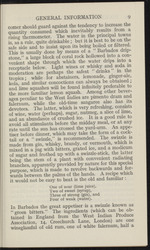 |
“...results from a
rising thermometer. The water in the principal towns
is, as a rule, quite drinkable; but itls bestto beonthe
safe side and to insist upon its being boded or filtered.
This is usually done by means of a Barbados drip-
stone,” a large block of coral rock hollowed into a con-
venient shape through which the water drips into a
receptacle below. Light wines or whisky and soda m
moderation are perhaps the safest drinks m the
tropics; while for abstainers, lemonade, ginger-ale,
kola and similar concoctions can always be obtained;
and lime squashes will be found infinitely preferable to
the more familiar lemon squash. Among other bever-
ages peculiar to the West Indies are pimento dram and
falemum, while the old-time sangaree also has its
devotees. The latter, which is very refreshing, consists
of wine, water (perhaps), sugar, nutmeg, a slice of lime,
and an abundance of crushed ice. It is a good rule to
avoid all stimulants before the midday meal, or at any
rate until the sun has crossed...”
|
|
| 2 |
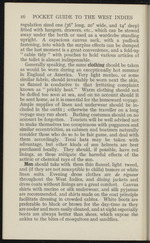 |
“...pouches to hold various articles of
the toilet is almost indispensable.
Generally speaking, the same clothing should be taken
as would be worn during an exceptionally hot summer
in England or America. Very light merino, or some
similar fabric, should invariably be worn next the skin,
as flannel is conducive to that irritating complaint
known as “ prickly heat." Warm clothing should not
be doffed too soon at sea, and on no account should it
be sent home, as it is essential for the homeward voyage.
Ample supplies of linen and underwear should be in-
cluded in the outfit; otherwise the traveller on a long
voyage may run short. Bathing costumes should on no
account be forgotten. Tourists will be well advised not
to make themselves too conspicuous with puggarees and
similar eccentricities, as cabmen and boatmen naturally
consider those who do so to be fair game, and deal with
them accordingly. Terai hats may be taken with
advantage, but other kinds of sun helmets are best
purchased locally. They...”
|
|
| 3 |
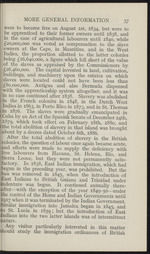 |
“...Havana, St. Helena, Rio, and
[Sierra Leone, but they were not permanently satis-
factory. In 1838, East Indian immigration, which had
begun in the preceding year, was prohibited. But the
fban was removed in 1845, when the introduction of
East Indians to British Guiana and Trinidad under
[indenture was begun. It continued annually there-
after—with the exception of the year 1849-50—under
the control of the Home and Indian Governments until
#917 when it was terminated by the Indian Government.
[Similar immigration into Jamaica began in 1845, and
lo St. Lucia in 1859 > but the introduction of East
Indians into the two latter islands was of intermittent
ilature.
I Any visitor particularly interested in this matter
mould study the immigration ordinances of British
■...”
|
|
| 4 |
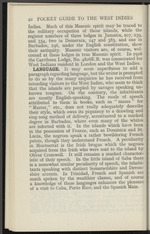 |
“...degree in Barbados, where even many of the whites
are infected with it. In the islands which have been
in the possession of France, such as Dominica and St.
Lucia, the negroes speak a rather bewildering French
patois, though they understand French. A peculiarity
in Montserrat is the Irish brogue which the negroes
acquired from the Irish who were sent to the island by
Oliver Cromwell. It still remains a marked character-
istic of their speech. In the little island of Saba there
is a somewhat similar peculiarity of speech, the inhabi-
tants speaking with distinct Somersetshire and Devon-
shire accents. In Trinidad, French and Spanish are
much spoken by the wealthier classes, and of course
a knowledge of these languages enhances the pleasure
of a visit to Cuba, Porto Rico, and the Spanish Main....”
|
|
| 5 |
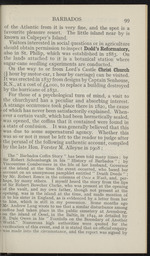 |
“...pamphlet entitled " Death Deeds ” •
by Mr. Robert Reece in the columns of Once a Week, and, peri
haps, by many others. I myself heard the story from the lips
of Sir Robert Bowcher Clarke, who was present at the opening
of the vault, and my own father, though not present at the
, opening, was in the island at the time, and made mention of
(it to his sister in England, as is evidenced by a letter from her
similar disturbance among
coffins had taken place in the public cemetery at Arensburg
on the island of Oesel, in the Baltic, in 1844, as detailed by
R. Dale Owen in his " Footfalls on the Boundary of Another
|1{ World. Numerous high authorities were quoted for the
Verification of this event, and it is stated that an official enquiry
was made into the circumstance, and the report was signed by...”
|
|
| 6 |
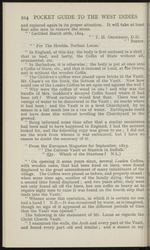 |
“...set upon end against the wall ?
“ Why were the coffins of wood in situ ? and why was the
bundle of Mrs. Goddard’s decayed Coffin found where it had
been left ? Wood certainly would first float. There was no
vestige of water to be discovered in the Vault; no marks where
it had been ; and the Vault is in a level Churchyard, by no
means in a fall much less in a run of water. Earthquake could
not have done this without levelling the Churchyard to the
ground.
“ Being informed some time after that a similar occurrence
had been said to have happened in England, I had the account
looked for, and the following copy was given to me ; I did not
see the work from whence it was extricated, but I have no
reason to doubt the accuracy of it.
" From the European Magazine for September, 1815.
“ ' The Curious Vault at Stanton in Suffolk.’
“ (Qy. Which of the Stantons ? N.L.)
" ' On opening it some years since, several Leaden Coffins,
with wooden cases, that had been fixed on biers, were found
displaced to the...”
|
|
| 7 |
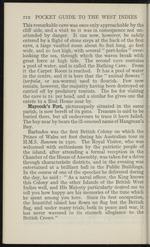 |
“...several “ port-holes ” over-
looking the sea, through which the waves break with
great force at high tide. The second cave contains
a pool of water, and is called the Bathing Cave. From j
it the Carpet Room is reached. It has a pool of water J
in the centre, and it is here that the “ animal flowers ”
{serpula, or sea-worms) used to flourish. Few now j
remain, however, the majority having been destroyed or
carried off by predatory tourists. The fee for visiting |
the cave is is. per head, and a similar fee gives one the ;
entrée to a Rest House near by.
Maycock’s Fort, picturesquely situated in the same |
parish, is now bereft of its guns. Treasure is said to be I j
buried there, but all endeavours to trace it have failed. |j
The bay near by bears the ill-omened name of Hangman’s |,
Bay. I
Barbados was the first British Colony on which the l|
Prince of Wales set foot during his Australian tour in j(
H.M.S. Renown in 1920. The Royal Visitor, who was I;
welcomed with enthusiasm by the patriotic...”
|
|
| 8 |
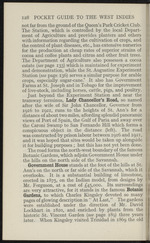 |
“...local Depart-
ment of Agriculture and provides planters and others
with information regarding the cultivation of crops, and
the control of plant diseases, etc., has extensive nurseries
for the production at cheap rates of superior strains of
cocoa and coffee plants and citrus and other fruit trees.
The Department of Agriculture also possesses a cocoa I
estate (see page 133) which is maintained for experiment
and demonstration, while the St. Augustine Experiment
Station (see page 136) serves a similar purpose for arable
crops, especially sugar-cane* It also has Government I
Farms at St. Joseph and in Tobago for the improvement
of live-stock, including horses, cattle, pigs, and poultry. I
Just beyond the Experiment Station and near the I
tramway terminus, Lady Chancellor’s Road, so named I
after the wife of Sir John Chancellor, Governor from I
1916 to 1921, runs to the heights of St. Ann’s for a I
distance of about two miles, affording splendid panoramic I
views of Port of Spain, the Gulf of...”
|
|
| 9 |
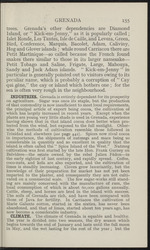 |
“...GRENADA
155
trees. Grenada’s other dependencies are Diamond
Island, or " Kick-em-Jenny,” as it is popularly called;
Islet Ronde, Les Tantes, Isle de Caille, and Levera, Green,
: Bird, Conference, Marquis, Bacolet, Adam, Caliviny,
Hog and Glover islands; while round Carriacou there are
Petit Martinique—so called because the French found
snakes there similar to those in its larger namesake—
Petit Tobago and Saline, Frigate, Large, Mabouya,
[ Sandy and Jack Adam islands. “ Kick-em-Jenny ” in
particular is generally pointed out to visitors owing to its
peculiar name, which is probably a corruption of “ Cay
qui gêne,” the cay or island which bothers one ; for the
| sea is often very rough in the neighbourhood.
INDUSTRIES. Grenada is entirely dependent for its prosperity
I on agriculture. Sugar was once its staple, but the production
I of that commodity is now insufficient to meet local requirements,
I the principal article of export being cocoa, the cultivation of
I which has largely increased...”
|
|
| 10 |
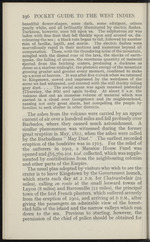 |
“...grey dust. . . . The awful scene was again renewed yesterday
(Thursday, the 8th) and again to-day. At about 8 a.m. the
volcano shot out an immense volume of material which was
carried in a cloud over Georgetown and its neighbourhood,
causing not only great alarm, but compelling the people by
families to seek shelter in other districts.
The ashes from the volcano were carried by an upper
current of air over a hundred miles and fell profusely over
Barbados, where they caused much astonishment. A
similar phenomenon was witnessed during the former
great eruption in May, 1812, when the ashes were called
by the Barbadians “ May Dust.” The earliest recorded
eruption of the Soufrière was in 1715. For the relief of
the sufferers in 1902, a Mansion House Fund was
opened and £65,76910s. 10d. collected, which was supple-
mented by contributions from the neighbouring colonies
and other parts of the Empire.
The usual plan adopted by visitors who wish to see the
crater is to leave Kingstown by the Government...”
|
|
| 11 |
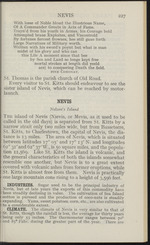 |
“...(St. Kitts is almost free from them. Nevis is practically
one large mountain cone rising to a height of 3,596 feet.
INDUSTRIES. Sugar used to be the principal industry of
; Nevis, but of late years the exports of this commodity have
!l been steadily declining in value. The cultivation of Sea Island
icotton is pursued and the production of coco-nuts is steadily
J expanding. Yams, sweet potatoes, corn, etc., are also cultivated
I to a considerable extent.
CLIMATE. The-climate of Nevis is very similar to that of
S St. Kitts, though the rainfall is less, the average for thirty years
«being only 53 inches. The thermometer ranges between 70°
land 85° Fahr. during the greater part of the year. There are...”
|
|
| 12 |
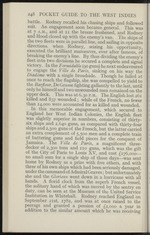 |
“...ships which had been seriously damaged, j
under the command of Admiral Graves; but unfortunately ! i
she and the Glorieux went down in a hurricane with all ji
hands. A florid clock from the superb French vessel, j 1
the solitary hand of which was moved by the sentry on
duty, can be seen at the Museum of the United Service
Institution in Whitehall. Rodney reached England bn
September 21st, 1782, and was at once raised to the
peerage and granted a pension of £2,000 a year in j
addition to the similar amount which he was receiving !...”
|
|
| 13 |
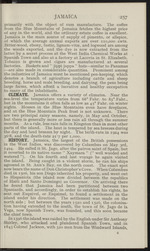 |
“...estate coffee is excellent.
Jamaica is the main source of supply of pimento, or allspice,
of which the average annual exports are over 110,000 cwts.
Bitter-wood, ebony, fustic, lignum-vitae, and logwood are among
the woods exported, and the • dye is now extracted from the
latter by a secret process at the West India Chemical Works at
Spanish Town and also at a factory at Lacovia in St. Elizabeth.
Tobacco is grown and cigars are manufactured at several
factories. Baskets and ‘' jippi jappa ” hats—similar to Panamas
—are also made in considerable quantities. Prominent among
the industries of Jamaica must be mentioned pen-keeping, which
denotes a branch of agriculture including cattle and sheep
breeding, horse and mule breeding, and dairying, the pens being
large farms, which afford a lucrative and healthy occupation
to many of the inhabitants.
CLIMATE. Jamaica offers a variety of climates. Near the
sea-level the temperature varies from 68° Fahr. to 85° Fahr.,
but in the mountains it often falls...”
|
|
| 14 |
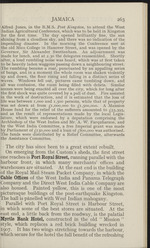 |
“...lunch, and at 2.30 the delegates reassembled. Shortly
1 after, a loud rumbling noise was heard, which was at first taken
: to be heavily laden waggons passing down a neighbouring street.
I The rumbling became a roar, punctuated by an appalling series
: of bangs, and in a moment the whole room was shaken violently
up and down, the floor rising and falling in a distinct series of
waves. Windows fell out, pictures came tumbling down, and
1 all was- confusion, the room being filled with debris. Similar
1 scenes were being enacted all over the city, which for long after
the first shock was quite covered by a pall of dust. Fire assisted
in the work of destruction, and it is estimated that the loss of
life was, between 1,000 and 1,500 persons, while that óf property
was set down at from £1,000,000 to £1,500,000. A Mansion
House fund for the relief of the sufferers amounted to £55,395,
and as the result of representations made by the local Legis-
lature, which were endorsed by a deputation comprising...”
|
|
| 15 |
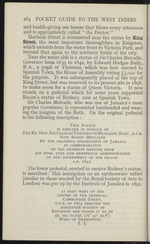 |
“...and wear-
ing the insignia of the Bath. On the original pedestal
is the following inscription :
This Statue
IS ERECTED IN HONOUR OF
The Rt. Hon. Sir Charles Theophilus Metcalfe, Bart., k.c.b.
Now Baron Metcalfe
By the grateful inhabitants of Jamaica
IN COMMEMORATION
OF THE BENEFITS DERIVED FROM
HIS WISE, JUST AND BENEFICIAL ADMINISTRATION
OF THE GOVERNMENT OF THE ISLAND
A.D. 1845.
The lower pedestal, erected to receive Rodney’s statue,
is inscribed: This inscription on an earthenware tablet
(similar to those erected by the Royal Society of Arts in
London) was put up by the Institute of Jamaica in 1892.
12 FEET WEST OF THE
CENTRE OF THE PEDESTAL,
Commander Green,
U.S.N. IN 1875 ERECTED THE
LONGITUDE STATION OF
Kingston and foond jt to be
5h. 7m. 10.65s. (76’ 47' 39.8')
West of Greenwich.
I. J....”
|
|
| 16 |
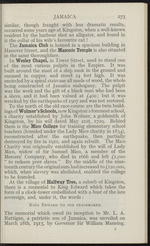 |
“...JAMAICA 273
similar, though fraught with less dramatic results,
occurred some years ago at Kingston, when a well-known
resident by the harbour shot an alligator, and found in
it the collar of his wife’s favourite cat!
The Jamaica Club is housed in a spacious building in
Hanover Street, and the Masonic Temple is also situated
in the same thoroughfare.
In Wesley Chapel, in Tower Street, used to stand one
of the most curious pulpits in the Empire. It was
built around the mast of a ship sunk in the ground and
encased in copper, and stood 24 feet high. It was
encircled by a spiral staircase all made of wood, the whole
being constructed of Jamaica mahogany. The pulpit
was the work and the gift of a black man who had been
a slave, and it had been valued at £400; but it was
wrecked by the earthquake of 1907 and was not restored.
To the north of the old race-course are the twin build-
ings of Wolmer’s Schools, now Kingston’s foremost school,
a charity established by John Wolmer, a goldsmith of
Kingston...”
|
|
| 17 |
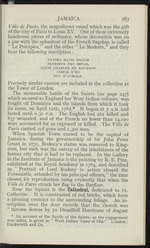 |
“...JAMAICA 283
Ville de Paris, the magnificent vessel which was the gift
of the city of Paris to Louis XV. One of these extremely
handsome pieces of ordnance, whose decoration was on
a par with the splendour of the French flagship, is called
“ Le Précipice,” and the other “ Le Modeste,” and they
bear the following inscription :
ULTIMA RATIO REGUM
PLURIBUS NEC IMPAR,
LOUIS CHARLES DE BOURBON
COMTE d’eU
DUC D’AUMALE.
Precisely similar cannon are included in the collection at
the Tower of London.
The memorable battle of the Saints (see page 247)
which secured to England her West Indian colonies, was
fought off Dominica and the islands from which it took
its name, on April 12th, 1782.* It began at 7 a.m. and
lasted until 6.30 p.m. The English lost 261 killed and
837 wounded, and of the French no fewer than 14,000
were accounted for as captured or killed. The Ville de
Paris carried 108 guns and 1,300 men.
When Spanish Town ceased to be the capital of
Jamaica, during the governorship of Sir John...”
|
|
| 18 |
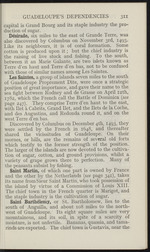 |
“...GUADELOUPE'S DEPENDENCIES 311
capital is Grand Bourg and its staple industry the pro-
duction of sugar.
Désirade, six miles to the east of Grande Terre, was
also discovered by Columbus on November 3rd, 1493-
Like its neighbours, it is of coral formation. Some
cotton is produced upon it; but the chief industry is
the raising of live stock and fishing. To the- south,
between it an Marie Galante, are two islets knbwn as
Terre d’en haut and Terre d’en bas, not to be confused
with those of similar names among Les Saintes.
Les Saintes, a group of islands seven miles to the south
of Guadeloupe Proprement Dite, were once a strategic
position of great importance, and gave their name to the
sea fight between Rodney and de Grasse on April 12th,
1782, which the French call the Battle of Dominica (see
page 247). They comprise Terre d’en haut to the east,
with Ilet a Cabrits, Grand Ilet, and the Ilets de la Coche,
and des Augustins, and Redonda round it, and on the
west Terre d’en bas.
Discovered by...”
|
|
| 19 |
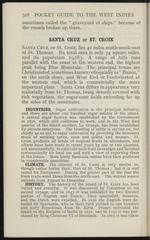 |
“...an aid to sugar cultivation by providing the necessary
stock of working cattle, oxen and mules, and manure. St.
Croix produces all kinds of tropical fruits in abundance, and
efforts have been made in recent years by one or two planters,
not unsuccessfully, to cultivate such fruit as oranges and bananas
systematically for local use and with a view of exporting them
in the future. More lately Bermuda onions have been produced
in considerable quantities.
CLIMATE. The climate of St. Croix is very similar to,
though rather hotter than, that of St. Thomas; but it is well
suited for Europeans. During the greater part of the year the
fresh trade-wind blows from the north-east. The wettest season
extends from August to December.
HISTORY. The history of the island of St. Croix has been
varied and eventful. It was discovered by Columbus on his
second voyage, and in 1643 it was inhabited by two distinct
parties of English and Dutch. They quarrelled, however,
and the Dutch were expelled. In 1650 the English...”
|
|
| 20 |
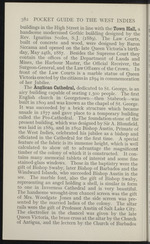 |
“...time. A special
feature of the fabric is its immense height, which is well
calculated to show off to advantage the magnificent
timber of the colony of which it is constructed. It con-
tains many memorial tablets of interest and some fine
stained-glass windows. Those in the baptistry were the
gift of Bishop Swaby, later Bishop of Barbados and the
Windward Islands, who succeeded Bishop Austin in the
see. The marble font, also the gift of Bishop Swaby,
representing an angel holding a shell, is similar in form
to one in Inverness Cathedral and is very beautiful.
The handsome wrought-iron chancel screen was the gift
of Mrs. Woodgate Jones and the side screen was pre-
sented by the married ladies of the colony. The altar
rails were the gift of Professor Austin of Salt Lake City.
The electrolier in the chancel was given by the late
Queen Victoria, the brass cross at the altar by the Church
of Antigua, and the lectern by the Church of Barbados...”
|
|
